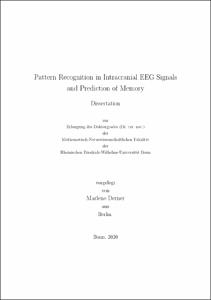Derner, Marlene: Pattern Recognition in Intracranial EEG Signals and Prediction of Memory. - Bonn, 2021. - Dissertation, Rheinische Friedrich-Wilhelms-Universität Bonn.
Online-Ausgabe in bonndoc: https://nbn-resolving.org/urn:nbn:de:hbz:5-61514
Online-Ausgabe in bonndoc: https://nbn-resolving.org/urn:nbn:de:hbz:5-61514
@phdthesis{handle:20.500.11811/8975,
urn: https://nbn-resolving.org/urn:nbn:de:hbz:5-61514,
author = {{Marlene Derner}},
title = {Pattern Recognition in Intracranial EEG Signals and Prediction of Memory},
school = {Rheinische Friedrich-Wilhelms-Universität Bonn},
year = 2021,
month = mar,
note = {This thesis presents a method for pattern recognition in neurocognitive data, in particular intracranial electroencephalographic (iEEG) data. The approach aims to reveal mechanisms underlying cognitive processes. This means that the algorithm has not only been designed to achieve above chance prediction results, but also to offer a better understanding and new insights into the functionality of the brain.
A support vector machine algorithm has been developed which deals with the complex data structure, the high number of potential datapoints and features, as well as the typically small and unbalanced sample sizes. In particular, the periodicity of phase measures is taken into account for statistics and training of the model. Background information about cognitive processes provides an informative basis for feature selection. Time series analysis is used for feature extraction and circular statistics cope with the periodic characteristics of the data entering feature preselection.
Then the algorithm was applied to iEEG data recorded in presurgical epilepsy patients during a continuous word recognition task. In two studies, memory formation was successfully predicted based on iEEG measures from rhinal cortex and hippocampus, two memory-related brain regions. Different iEEG measures (i.e. absolute phases, phase shifts and power values) were compared for their predictive capabilities. The results obtained by training the algorithm with iEEG data reveal the superiority of absolute phases compared to the other measures and their importance for memory processes. Hence, the presented method is able to provide valuable insights into basic mechanisms of brain functions.
Finally, a further application comprising memory enhancement methods is presented. Here, the results of the previous application are turned into assumptions for further research. In particular, 5 Hz auditory beat stimulation was applied during an associative memory task. It was shown that phase locking was increased and that memory performance was altered depending on absolute phase values. These findings confirmed the importance of oscillatory phases for memory formation and the informative value of the previous outcomes. Taken together, the presented algorithm is able to expose key information patterns derived from neurocognitive data and might be used in memory enhancement applications.},
url = {https://hdl.handle.net/20.500.11811/8975}
}
urn: https://nbn-resolving.org/urn:nbn:de:hbz:5-61514,
author = {{Marlene Derner}},
title = {Pattern Recognition in Intracranial EEG Signals and Prediction of Memory},
school = {Rheinische Friedrich-Wilhelms-Universität Bonn},
year = 2021,
month = mar,
note = {This thesis presents a method for pattern recognition in neurocognitive data, in particular intracranial electroencephalographic (iEEG) data. The approach aims to reveal mechanisms underlying cognitive processes. This means that the algorithm has not only been designed to achieve above chance prediction results, but also to offer a better understanding and new insights into the functionality of the brain.
A support vector machine algorithm has been developed which deals with the complex data structure, the high number of potential datapoints and features, as well as the typically small and unbalanced sample sizes. In particular, the periodicity of phase measures is taken into account for statistics and training of the model. Background information about cognitive processes provides an informative basis for feature selection. Time series analysis is used for feature extraction and circular statistics cope with the periodic characteristics of the data entering feature preselection.
Then the algorithm was applied to iEEG data recorded in presurgical epilepsy patients during a continuous word recognition task. In two studies, memory formation was successfully predicted based on iEEG measures from rhinal cortex and hippocampus, two memory-related brain regions. Different iEEG measures (i.e. absolute phases, phase shifts and power values) were compared for their predictive capabilities. The results obtained by training the algorithm with iEEG data reveal the superiority of absolute phases compared to the other measures and their importance for memory processes. Hence, the presented method is able to provide valuable insights into basic mechanisms of brain functions.
Finally, a further application comprising memory enhancement methods is presented. Here, the results of the previous application are turned into assumptions for further research. In particular, 5 Hz auditory beat stimulation was applied during an associative memory task. It was shown that phase locking was increased and that memory performance was altered depending on absolute phase values. These findings confirmed the importance of oscillatory phases for memory formation and the informative value of the previous outcomes. Taken together, the presented algorithm is able to expose key information patterns derived from neurocognitive data and might be used in memory enhancement applications.},
url = {https://hdl.handle.net/20.500.11811/8975}
}






